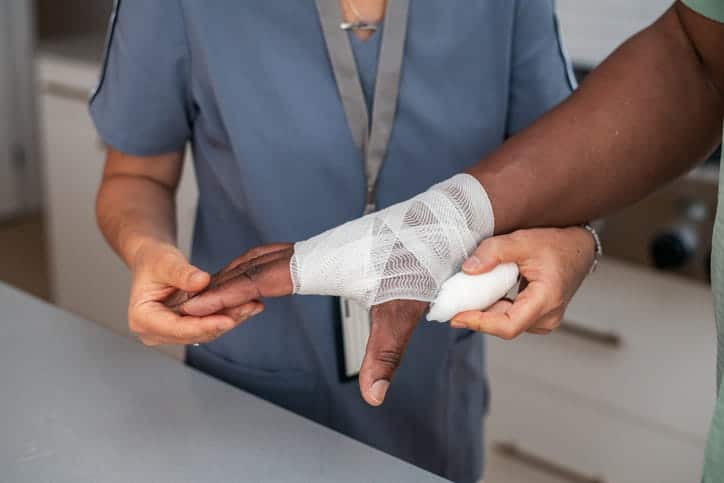Work Industries Where Burn Injuries Most Frequently Occur

Burns are serious injuries involving damage to the skin or other organs. Burn injuries are ranked by degree of severity, with first-degree burns being minor burns causing some discoloration and pain. Fourth-degree burns damage every layer of your skin and can damage bones, muscles, and nerve endings.
The following five sources cause burn injuries:
- Chemical: Contact with chemicals, such as paint thinner or drain cleaner, causes chemical burns
- Electrical: Contact with electrical currents causes electrical burns
- Friction: Striking something while it’s in motion or while you’re in motion can cause friction burns. For example, you could get friction burns if your bare skin slides across the carpet.
- Radiation: Exposure to radiation or UV rays from sunlight causes radiation burns
- Thermal: External heat sources cause thermal burns. These burns include scalding from hot water and contact with hot objects.
Workers are exposed to burn injury sources in common work industries. Let’s look at some industries with higher risks of burn injuries and your options if you’re burned at work.
If you have been injured at work, get in touch with our injury lawyers today.
Common Work Industries Where Burn Injuries Occur
Burns are one of the most common work injuries, accounting for approximately 42% of work injuries. Although work accidents can cause burns in other industries, people working in the trades are routinely exposed to dangerous working conditions, increasing their risk of burns. Trades where burn injuries are common include:
- Construction workers: Construction workers may have prolonged exposure to UV rays, come in contact with electrical wires, or suffer chemical burns from paint thinner and other chemicals used in their workplace.
- Electricians: Electricians work with electrical wires and may suffer electrical burns from contact with electricity.
- Landscapers: Radiation burns are common because landscapers have prolonged exposure to UV rays during their work hours.
- Welders: Welders work with heated equipment and create sparks that fly through the air. Contact with their equipment or these sparks can cause thermal burns.
Elevator mechanics and painters are also at risk because of contact with wiring and paint thinner.
Other Industries Where Burn Injuries Are Common
In addition to the risk of burns to people in the trades, the following industries have an increased risk of burn injuries:
- Firefighters: Firefighters are at risk of direct contact with open flames
- Hospitality and food service workers: Hospitality and food service workers can suffer thermal burns from direct contact with hot objects and scalding liquids.
- Manufacturing: People in manufacturing can be exposed to chemicals, electricity, and hot objects, putting them at risk of suffering chemical, electrical, and thermal burns.
- Mining workers: There is an increased risk of fires in mine shafts, which can cause thermal burns.
- Oil rig workers: Oil rig workers exposed to chemicals used in their workplace can suffer chemical burns.
What to Do if You Are Burned at Work
Burns can cause life-changing injuries, leading to expensive medical bills. Protecting your health and legal rights begins with understanding what to do if you have been burned at work. Take the following steps after suffering a workplace burn injury:
- Report your accident: Start by reporting your injury. You must notify your employer about your injury and complete an incident report.
- Seek medical care: Seek prompt medical care for your burns and any other injuries. Seek medical tests and care from a professional who can diagnose and treat your condition.
- Consult an attorney: Burn injury attorneys offer free consultations, ensuring you can receive expert legal guidance after an accident. Talking to an attorney is the best way to confirm your legal options and get help filing for workers’ compensation.
- File for workers’ compensation: Employees can seek workers’ compensation benefits. Workers’ compensation pays a percentage of lost income to those unable to work while recovering. It also covers medical expenses.
Can You Sue Your Employer for a Burn Injury at Work?
In most cases, employers are protected from injury lawsuits. You would have to prove your employer was guilty of gross negligence to make a compelling legal claim for damages. You may also have grounds for a legal case if another party caused your injuries.
Suppose you’re using a new piece of equipment that is defective. It malfunctions, and you’re sprayed with scalding liquid, causing burns. You may have a case against the equipment manufacturer.
Car accidents are another common source of burn fatalities and injuries. If you’re in an accident while driving for work, you may have a claim against the at-fault party responsible for the crash.
What if My Workers’ Compensation Claim Is Denied?
Your lawyer can prepare an appeal for a denied workers’ compensation claim. You should discuss your options with a burn injury lawyer if you have not consulted an attorney.
If You Have Been Burned at Work, Call the Experts at Bachus & Schanker

Bachus & Schanker understand the trauma of suffering a catastrophic, life-changing injury. We created a Victim’s Advocate group staffed by former law enforcement and legal professionals who investigate accidents and gather evidence to support our client’s claims. Our advocates can also help victims find financial resources they can use while waiting to resolve their case.
Our legal team is ready to help you get fair compensation for your workplace burn injury. Whether you need to appeal a workers’ compensation denial or file a claim against a third party, we’ll help you navigate the legal process and fight for you to receive the justice you deserve.
Let the work litigation lawyers at Elite Litigation Group help you with your burn injury claim.
